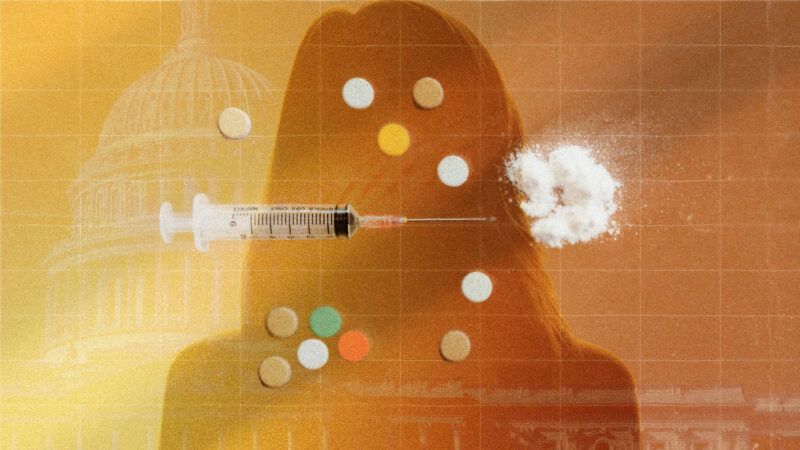The Fight To Criminalize Opioid Prescribing
Over 88 percent of opioid overdose deaths now involve either heroin or fentanyl. Targeting prescriptions is not an efficient way to address mortality.

As Americans continue to die from drug overdoses at an increasing rate, policy makers are seeking interventions to reduce reckless medical practices that put patients in danger of addiction. Many of these proposed laws seek to limit the extent to which patients can access prescription opioids from their physicians. But as our new study, published this week in the Yale Law & Policy Review Inter Alia, argues, prescription opioids are not to blame for today's crisis.
Laws that arbitrarily set duration or quantity restrictions for opioid treatment regimens are premised on the belief that increased access to prescription opioids has led to an increase in addiction and, ultimately, overdose deaths.
However, while opioid deaths continue to soar, opioid prescribing rates have decreased every year since 2012. Further, nonmedical use of prescription opioids has remained relatively stable over the past two decades. As we point out in our study, the popularized spike in reported nonmedical opioid use rates between 1998 and 2002 was most likely caused by major changes in survey methodology. And if there was a true increase in nonmedical opioid use, it would have been due to codeine, not the overprescribing of common pain relievers like OxyContin. The claim that the introduction of OxyContin in 1996 "fueled" prescription opioid use is simply not supported by the data.
Such claims about Purdue Pharma, however, were echoed during last week's House Energy and Commerce hearing on combatting fentanyl overdoses. Rep. Tony Cárdenas (D–Calif.) prefaced his questioning with "Purdue, the Sackler family, and crime pays—still one of the richest families in the world…who was a big part of where we are today." Rep. Mariannette Miller-Meeks (R–Iowa) shared a similar sentiment: "As we know, a lot of opioid addiction has started through post-operative care and pain management, pain relief."
But it is illicit opioids like heroin and fentanyl, not prescription pain relievers, that are primarily to blame for today's opioid crisis. By decreasing access to legal channels of prescribing, laws restricting the use of prescription opioids only increase the likelihood that a pain patient will need to turn to the black market to meet his demand for opioids with dangerous illicit drugs.
And yet, academics and policymakers continue to pursue reforms that would only exacerbate this issue. For example, Loyola Marymount University law professor Rebecca Delfino proposed that Congress adopt the Prescription Abuse and Prevention Act (PAPA), a law that would make it easier to prosecute physicians for violating the Controlled Substances Act (CSA). No legislation has yet to be introduced that cites PAPA, but policy makers have shown an appetite to criminalize doctors for prescribing opioids in the past.
Under the CSA and regulations pursuant to it, it is illegal for a physician to "knowingly or intentionally" prescribe a controlled substance unless the prescription is "for a legitimate medical purpose…in the usual course of his professional practice." Like the CSA, PAPA offers an intent or knowledge mens rea standard, but also allows a "presumption of knowledge" to be established by a "doctor's expert knowledge, practice experience, and specialized medical training."
Simply put, if a patient overdoses on a medication that was prescribed by a physician, the event itself might be sufficient to convict the prescriber of second-degree murder. This is because the doctor's expertise should have prevented the patient from being in such a vulnerable situation in the first place.
Although it shouldn't be expected that prosecutors would go after every physician whose patient overdoses under PAPA, the fact that such an event would likely lead to an automatic conviction after a charge would worry many physicians. Moreover, PAPA could grant prosecutors the arbitrary authority to incarcerate any physician whose patient overdoses while under his care. Such potential liability would lead to further reductions in prescribing across the country, which would only increase illicit opioid deaths.
Last term, the Supreme Court clarified in Ruan v. United States that in order to be liable under the CSA, a physician must have "knowingly or intentionally acted in an unauthorized manner," rather than merely intended to or known that he was prescribing some controlled substance. While the CSA regime is not perfect, the ruling in Ruan provided much-needed clarity to the standard of liability under the CSA and shielded physicians from facing prosecution for simply doing their job as authorized.
Criminalizing doctors is not the path to ending the opioid crisis. As much of the literature indicates, opioid prescriptions rarely lead to addiction when treating either acute or chronic pain. Given that over 88 percent of opioid overdose deaths now involve either heroin or fentanyl, targeting prescriptions is not an efficient way to address mortality. The way forward is to expand access to both addiction and pain patients, so that those who are in most need of a safe environment to consume opioids can do so legally.
Show Comments (87)